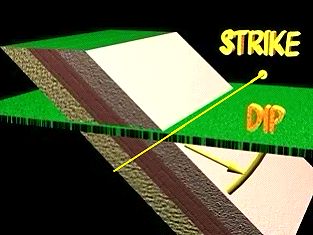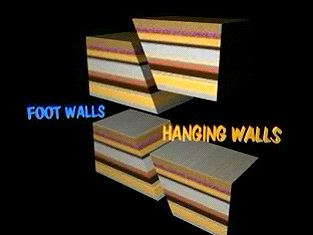
Brittle deformation: chalk, glass, (Will break more often than bend)
Ductile Deformation: copper, butter, rubber, (Will bend more before breaking)
Things that promote Ductile Bending:
1.) heat (plastic, glass, etc. etc.)
2.) water or moisture (wet clay vs dry clay, wet wood vs. dry wood, etc.)
3.) rate of applied stress. (You can bend wood slowly but not rapidly)
When the underlying rock is no longer in a horizontal pattern, it can still be mapped. The two defined directions are called dip and strike.
The strike is the direction which the inclined sediment crosses ground level. It can sometimes be determined by mapping many rock out croppings and then aligning them until the direction can be ascertained.
The dip is the angle of incline of the raised beds into the earth. It is measured from the horizontal down to the dipping plane.


The hanging wall is the wall that is located above the fault line. The lower block is called the footwall. It makes no difference which way the rocks move only their relative location.
Normal fault: hanging wall drops (down direction)
Reverse fault: hanging wall rises (up direction)
Strike fault: walls move like transverse plates
Oblique fault: like the movie - two directions.
Hinge fault: fault becomes wider at one end
| NEXT | TOC | PREV |